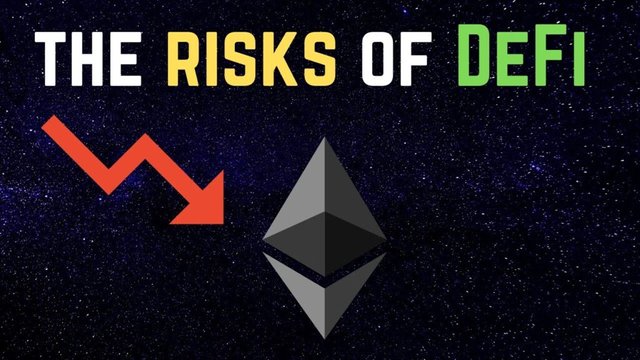Risks associated with DeFi : Diving into DeFi
A Guide To Financial Risks involved with DeFi.
October 12th, 2020 #Steemcryptochallenge Week #2 Diving into DeFi by @steemitblog

Risk in DeFi
We can learn a lot about how to assess the risk of DeFi products by looking at the traditional financial system. According to Investopedia, “Risk takes on many forms but is broadly categorized as the chance an outcome or investment’s actual gain will differ from the expected outcome or return.” In addition to considering whether or not an investment will provide a healthy return, investors need to consider the technical or systemic risks associated with an investment opportunity as well as their own approach to investing.
A typical risk assessment includes consideration for an investor’s risk appetite, the amount of risk an investor is willing to take on in pursuit of a reward, in addition to looking at the risks associated with a given investment product. High-reward opportunities tend to come with a lot of risks that investors looking for stable growth may not be willing to take on. In addition to thinking about financial risks, making an investment in DeFi requires specialized knowledge about how to obtain and use cryptocurrency in a secure manner. This is part of the reason investing in DeFi can still be considered a high-risk opportunity.
For those with a high-risk appetite or individuals simply interested in understanding the risk of investing in DeFi, here are some of the risks specific to DeFi products:
Vulnerability
Smart contract security has come a long way since The DAO (decentralized autonomous organization) hack, but it would be irresponsible to claim that security doesn’t remain a major issue for dapps and smart contracts. Hackers still find valuable opportunities to seize cryptocurrency by watching block explorers to exploit vulnerabilities in smart contracts as they get deployed to various networks. Companies like Nexus Mutual have started developing insurance to cover problems like smart contract failure, but such products remain in their infancy and aren’t exactly battle-tested. Like all dapps, some DeFi products have received security audits, and some haven’t and at the end of the day, it’s up to users to do their own research and decide whether or not they feel comfortable risking their assets.
Security
In addition to the risk of vulnerabilities in the software created by the developers of DeFi products, those who use cryptocurrency take on risk associated with their potential failure to act in ways that put their assets at risk. Developers generally try to make their products as safe as possible, but cryptocurrency users take on the unique responsibility for securing their own private keys. Using a hardware wallet, multi-factor authentication, and keeping your holdings a secret are some of the important steps to consider.
Changing Of The System
Cryptocurrency enthusiasts are no strangers to the struggle involved in keeping up with updated protocols and changing terms of service among various cryptocurrency projects, digital wallets, and exchanges. Some DeFi products introduce a new dimension in that they have been paired with DAO’s that govern certain aspects of a platform or protocol. For example, holders of the MakerDAO token can vote on the stability fee intended to help keep supply and demand for the Dai stablecoin in check. Stability fees have been less than a percent at certain times and as high as twenty percent at others, so keeping up with these types of changes will be critical for investors who decide to use DeFi products.
Financial risk
Investors typically use historical data and benchmarks like the annual inflation of their native currency and the risk-free rate of return to evaluate investment opportunities. The risk-free rate refers to how much an investor can expect to make from an investment offering the closest thing to a guaranteed return as possible. U.S. investors typically look to the rates on 3-year U.S. treasury bill for a baseline of investment opportunities and factor in roughly 2% inflation per year. It has been proposed that an insured form of cDai, a token based on the Dai stablecoin that automatically gains variable interest using the Compound lending protocol, could come to be recognized as the risk-free rate for DeFi products. Whether or not this becomes the case, the lack of extensive historical data and benchmarks makes it difficult to evaluate the risk of investments in DeFi in traditional terms.
What's next for DeFi?
There’s no better way to learn about DeFi and the products coming out of this movement than by simply trying them out with small amounts of digital currency. That said, there remain significant hurdles to properly evaluate DeFi products as investment opportunities and investments in DeFi should be considered high-risk, accordingly. As an application of distributed ledger technology (DLT), DeFi has gained a significant amount of momentum and holds the promise to give people control over their finances in ways that have not been previously available. Once the risks can be properly understood, DeFi will be one step closer toward becoming an effective way to defy the current financial system.
Cc:-
@steemitblog
@steemcurator01
@steemcurator02
This post has been set to 100% power up.
https://twitter.com/KidoDecent/status/1315635242640777216
Might be good to work on getting some followers on Twitter...
I am kinda new to twitter so working on it!Thanks.